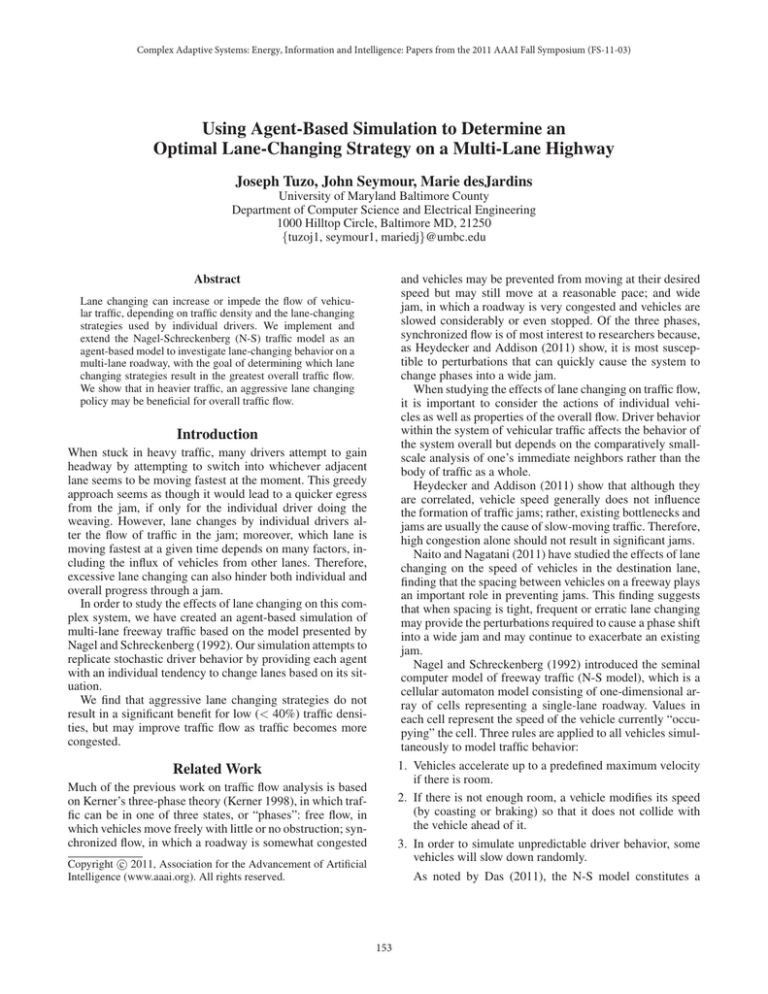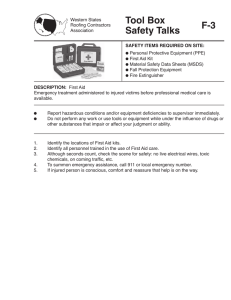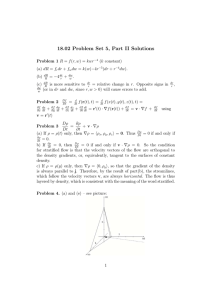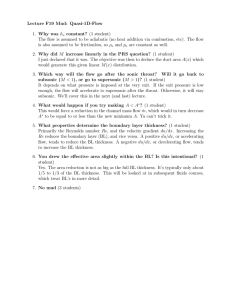
Complex Adaptive Systems: Energy, Information and Intelligence: Papers from the 2011 AAAI Fall Symposium (FS-11-03)
Using Agent-Based Simulation to Determine an
Optimal Lane-Changing Strategy on a Multi-Lane Highway
Joseph Tuzo, John Seymour, Marie desJardins
University of Maryland Baltimore County
Department of Computer Science and Electrical Engineering
1000 Hilltop Circle, Baltimore MD, 21250
{tuzoj1, seymour1, mariedj}@umbc.edu
and vehicles may be prevented from moving at their desired
speed but may still move at a reasonable pace; and wide
jam, in which a roadway is very congested and vehicles are
slowed considerably or even stopped. Of the three phases,
synchronized flow is of most interest to researchers because,
as Heydecker and Addison (2011) show, it is most susceptible to perturbations that can quickly cause the system to
change phases into a wide jam.
When studying the effects of lane changing on traffic flow,
it is important to consider the actions of individual vehicles as well as properties of the overall flow. Driver behavior
within the system of vehicular traffic affects the behavior of
the system overall but depends on the comparatively smallscale analysis of one’s immediate neighbors rather than the
body of traffic as a whole.
Heydecker and Addison (2011) show that although they
are correlated, vehicle speed generally does not influence
the formation of traffic jams; rather, existing bottlenecks and
jams are usually the cause of slow-moving traffic. Therefore,
high congestion alone should not result in significant jams.
Naito and Nagatani (2011) have studied the effects of lane
changing on the speed of vehicles in the destination lane,
finding that the spacing between vehicles on a freeway plays
an important role in preventing jams. This finding suggests
that when spacing is tight, frequent or erratic lane changing
may provide the perturbations required to cause a phase shift
into a wide jam and may continue to exacerbate an existing
jam.
Nagel and Schreckenberg (1992) introduced the seminal
computer model of freeway traffic (N-S model), which is a
cellular automaton model consisting of one-dimensional array of cells representing a single-lane roadway. Values in
each cell represent the speed of the vehicle currently “occupying” the cell. Three rules are applied to all vehicles simultaneously to model traffic behavior:
Abstract
Lane changing can increase or impede the flow of vehicular traffic, depending on traffic density and the lane-changing
strategies used by individual drivers. We implement and
extend the Nagel-Schreckenberg (N-S) traffic model as an
agent-based model to investigate lane-changing behavior on a
multi-lane roadway, with the goal of determining which lane
changing strategies result in the greatest overall traffic flow.
We show that in heavier traffic, an aggressive lane changing
policy may be beneficial for overall traffic flow.
Introduction
When stuck in heavy traffic, many drivers attempt to gain
headway by attempting to switch into whichever adjacent
lane seems to be moving fastest at the moment. This greedy
approach seems as though it would lead to a quicker egress
from the jam, if only for the individual driver doing the
weaving. However, lane changes by individual drivers alter the flow of traffic in the jam; moreover, which lane is
moving fastest at a given time depends on many factors, including the influx of vehicles from other lanes. Therefore,
excessive lane changing can also hinder both individual and
overall progress through a jam.
In order to study the effects of lane changing on this complex system, we have created an agent-based simulation of
multi-lane freeway traffic based on the model presented by
Nagel and Schreckenberg (1992). Our simulation attempts to
replicate stochastic driver behavior by providing each agent
with an individual tendency to change lanes based on its situation.
We find that aggressive lane changing strategies do not
result in a significant benefit for low (< 40%) traffic densities, but may improve traffic flow as traffic becomes more
congested.
1. Vehicles accelerate up to a predefined maximum velocity
if there is room.
2. If there is not enough room, a vehicle modifies its speed
(by coasting or braking) so that it does not collide with
the vehicle ahead of it.
3. In order to simulate unpredictable driver behavior, some
vehicles will slow down randomly.
Related Work
Much of the previous work on traffic flow analysis is based
on Kerner’s three-phase theory (Kerner 1998), in which traffic can be in one of three states, or “phases”: free flow, in
which vehicles move freely with little or no obstruction; synchronized flow, in which a roadway is somewhat congested
c 2011, Association for the Advancement of Artificial
Copyright Intelligence (www.aaai.org). All rights reserved.
As noted by Das (2011), the N-S model constitutes a
153
“minimal” simulation, because it cannot be simplified without ceasing to resemble real-world traffic. A number of other
researchers have built upon this model to implement more
accurate simulations, introducing features such as heterogeneous populations (Zhu, Ge, and Dai 2007; Lárraga and
Alvarez-Icaza 2010), slow-to-start behavior (Schadschneider and Schreckenberg 1997), rolling “trickle-flow” jams
(as opposed to complete stops) (Das 2011), “intertial” driver
behaviors (such as reaction time, which causes delayed response to stimuli) (Ding and Huang 2010), and multi-lane
dynamics (Tanaka, Nagatani, and Masukura 2008; Alperovich and Sopasakis 2008).1 These models report greater accuracy in replicating observed real-world traffic phenomena
than the base N-S model.
The measurements generally used to characterize traffic
include traffic density and traffic flow. Density, as proposed
by Nagel and Schreckenberg, is defined as the ratio of time
steps in which a specified cell in a discrete-spaced roadway
is occupied to the total number of time steps. Similarly, flow
is defined as the ratio of time steps during which a vehicle
is moving over a specified cell to the total number of time
steps.
Figure 1: Simulation environment. The sliders on the left
control the input parameters, while the readouts on the right
display and graph statistics about the traffic flow. The simulated roadway runs along the bottom.
sire,” and represents stochastic driver behavior in which a
driver does not have a readily apparent reason for changing
lanes.
Frustration-rate is a fixed real value that is used to modify
desire at each time step according to:
Model Design
Our approach extends the original N-S model by casting it
as an agent-based model and adding a heterogeneous population, multiple lanes, and lane changing behaviors. The
model is implemented using the freely available NetLogo
software (Wilensky 1999). We chose to extend the original
N-S model, rather than a derivative model, due to its ease of
implementation and minor overhead, which allowed simpler
analysis.
The model environment consists of a canvas representing
a multi-lane roadway. Traffic traverses the canvas in one direction and “loops around” from one end to the other, forming a closed, circular roadway. Each horizontal row of the
canvas represents a single lane of travel, while the length
of the canvas determines the “circumference” and thus the
maximum capacity of the road. Time and locations are measured as discrete, integral units.
Each NetLogo agent, or “turtle,” represents a drivervehicle entity, with state variables describing the vehicle’s
current and maximum speeds as well as the driver’s tendency to change lanes stochastically (tendency), current desire to change lanes (desire), and a “frustration” rate that
increments the driver’s desire the longer a vehicle is prevented from moving at its maximum speed. The values of
the driver’s variables determine whether an agent will employ a cautious or aggressive lane changing policy.
Speed and max-speed describe the current and maximum
speeds of a vehicle, respectively. Speed determines how
many cells a vehicle will attempt to move forward at each
time step (as in the N-S model), and max-speed places an
upper limit on speed.
Tendency is a fixed real value that determines the rate at
which a driver will change lanes without a sufficient “de-
⎧
desire ∗ (1 + frustration-rate)
⎪
⎪
⎪
⎪
if speed < max-speed
⎪
⎨
desire/(1 + frustration-rate)
desire =
if speed = max-speed
⎪
⎪
⎪
⎪
desire/2
⎪
⎩
if the agent has just changed lanes
(1)
This formula attempts to model building frustration as a
driver is stuck in slow traffic, decreasing frustration as they
move freely, and sudden relief felt after changing lanes into
(presumably) faster traffic.
The state variables for each agent are initialized randomly
within certain ranges, using a uniform distribution. Agents
may be placed at any unoccupied location on the grid, facing
forward (right). Each agent’s tendency, desire, frustrationrate, and maximum speed values are set randomly within
a range specified by the user. For the first three variables,
real values in the range [0, 1] are used, whereas the speed
is set as an integer value in the range [0, 5]. All random
values are generated by NetLogo’s internal random number
generator, which uses an implementation of the Mersenne
Twister algorithm.
Additional global parameters that can be set by the user
control the population size/density, global lane change tendency (lane-chg-prob), and proportion of right-merges to
left-merges when both are available. These values affect the
traffic at an overall rather than an individual level.
Agents in the model behave according to the following
rules:
1. If there is room to accelerate, do so according to the N-S
specification.
2. With probability tendency, attempt to change lanes (randomly) by moving sideways.
1 These final two sources analyze and characterize complexity in
multi-lane traffic but do not use this data to propose new strategies.
154
3. If there is room to accelerate:
(a) With probability lane-chg-prob:
i. With probability desire, attempt to change lanes (with
reason) by moving sideways.
ii. With probability (1 − desire), slow down.
(b) With probability (1 − lane-chg-prob), slow down.
4. If a lane change was unsuccessful, slow down.
5. Update desire according to Equation 1.
6. Move vehicle forward.
This rule set is applied to each vehicle in the simulation
atomically, so that any changes in the traffic configuration
will be reflected immediately after a vehicle moves instead
at the end of a time step.2
Experimental Design
Figure 2: Graphs of flow (green “X”) and avg-TTT (red “+”)
for lane-chg-prob = 0.2. Avg-TTT increases exponentially
with increasing density, while flow follows a parabolic arc.
Graphs of all other values of lane-chg-prob were similar in
shape.
Three attributes are used to characterize traffic in the simulation: traffic density, traffic flow, and traversal time.
Traffic density is measured, as in Nagel and Schreckenberg (1992), by calculating the ratio of the number of time
steps at which a given cell is “occupied” by a vehicle to the
total number of time steps. In our simulation, a line of cells
to be used for measurement is established across the three
lanes of the roadway, forming a “lap” line of sorts.
Traffic flow, again per Nagel and Schreckenberg, is calculated similarly to density but only considers vehicles that are
moving (speed > 0) at the time they are counted. We modify the calculation from the N-S model to reflect the average
flow per lane in multi-lane situations.
Traversal time is the number of time steps it takes a vehicle to travel one lap of the roadway. Each agent tracks its
time-to-traverse (TTT) for the current lap, for all laps, and its
average TTT. The global average time-to-traverse (avg-TTT)
is taken as the average of average TTT’s over all agents.
The experimental setup used for testing consists of three
lanes of length 100. For each agent, tendency is set to a random real value between 0 and 0.1, desire is set to a random
real value between 0 and 0.3, and frustration-rate is set to a
random real value between 0 and 0.1. Vehicles are created
with a maximum speed of 5 spaces per time step, and are
initialized with a random integer speed between 1 and 5.
10% increments from 0 to 1. Each permutation of parameters {population density, lane-chg-prob} was run 10 times
through a simulation of 10,000 steps. Table 1 shows the 10run average avg-TTT results for the test runs, while Table 2
gives the corresponding flow values.
In general, as traffic density increased, avg-TTT rose
exponentially, while flow followed a downward-facing
parabola (see Figure 2). This is intuitively sensible, since
when the traffic density is low, individual agents experience
high flow, but there are relatively few of them; conversely,
when the density is high, there is high congestion, and many
agents experience low flow.
The highest flow values overall were observed at a 40%
traffic density; at this density, reported flow was highest at
40% lane changing frequency, presenting a global maximum
for our given lane-changing problem. 40% density flow values were higher than those for any other density, suggesting
that 40% is an ideal density.
The effect of lane-chg-prob varied with the traffic density. At low densities, fluctuations in lane-chg-prob were statistically significant; however, the effects were minimal, as
shown in Figure 3. At high densities (above 40%), lane-chgprob was positively correlated with flow rate, as shown in
Figure 4.
Additionally, fluctuations at low values of lane-chg-prob
proved to be more significant than those at high values (see
Table 3): a jump from 0.1 to 0.2 is likely to be more significant than from 0.9 to 1.0.
Results
We conducted trials to determine the effects of lane changing on traffic flow at varying traffic densities. We tested population density in 10% increments from 10% to 80% (early
experiments showed that 90% and (trivially) 100% densities resulted in a complete deadlock), and lane-chg-prob in
2 Our model differs significantly in implementation from the NS model in this regard. N-S updates vehicle positions in parallel,
and its rule set is contrived to avoid collisions; since our rule set
has to account for the condition of an agent’s neighbors at the time
the agent makes a decision to move, updates must take into account
the current state of the roadway, and not the state at the beginning
of the time step. Note that this is an implementation detail, and
should not adversely affect the results of the simulation.
Conclusions and Future Work
Our model was able to generalize the Nagel-Schreckenberg
paradigm to include stochastic and deterministic lanechanging behavior.
We found that in general, a driver’s lane changing strat-
155
Density
10%
20%
30%
40%
50%
60%
70%
80%
0.0
27.65
45.34
71.06
109.56
171.42
278.01
484.96
981.03
0.1
27.51
45.39
70.45
108.19
169.69
275.76
481.80
973.66
0.2
27.38
45.01
70.11
107.41
168.31
273.72
479.72
971.44
0.3
27.52
45.08
70.10
107.00
166.88
272.36
476.40
966.84
lane-chg-prob
0.4
0.5
0.6
27.48
27.64
27.47
45.09
45.15
45.23
70.15
69.91
69.89
106.44 106.23 106.38
165.58 164.80 163.95
269.22 267.30 264.78
474.31 469.08 467.16
962.13 963.21 955.71
0.7
27.50
45.06
69.75
106.27
163.13
264.17
463.95
953.36
0.8
27.51
45.04
69.98
106.03
163.63
261.63
460.24
954.41
0.9
27.70
45.17
69.76
106.41
162.99
260.71
457.97
957.91
1.0
27.62
45.21
69.91
106.50
163.01
260.45
455.39
956.64
Table 1: Effects of varying lane-chg-prob (columns) on average time to traverse (avg-TTT) at different traffic densities (rows).
Avg-TTT is measured in units of time steps.
Density
10%
20%
30%
40%
50%
60%
70%
80%
0.0
0.0926
0.1667
0.2143
0.2315
0.2157
0.1751
0.1215
0.0637
0.1
0.0929
0.1650
0.2145
0.2334
0.2183
0.1758
0.1227
0.0646
0.2
0.0933
0.1661
0.2162
0.2345
0.2203
0.1783
0.1236
0.0652
0.3
0.0937
0.1648
0.2155
0.2372
0.2226
0.1795
0.1253
0.0661
lane-chg-prob
0.4
0.5
0.6
0.0938 0.0940 0.0939
0.1659 0.1642 0.1659
0.2155 0.2160 0.2169
0.2386 0.2381 0.2370
0.2249 0.2265 0.2265
0.1828 0.1861 0.1881
0.1271 0.1290 0.1313
0.0671 0.0677 0.0690
0.7
0.0923
0.1652
0.2152
0.2378
0.2280
0.1896
0.1343
0.0709
0.8
0.0937
0.1659
0.2157
0.2382
0.2293
0.1917
0.1362
0.0726
0.9
0.0931
0.1669
0.2161
0.2373
0.2294
0.1918
0.1409
0.0759
1.0
0.0934
0.1652
0.2159
0.2380
0.2294
0.1951
0.1455
0.0863
Table 2: Effects of varying lane-chg-prob (columns) on average flow at different traffic densities (rows). Flow is measured as
the number of cars passing the “lap” line per time step. Maximum flow (in italics) was observed at 40% density for all values
of lane-chg-prob.
Figure 3: Traffic flow at population 90, or 30% density. Lane
changing rate is not strongly correlated with flow, likely due
in part to the high variance of the sample.
Figure 4: Traffic flow at population 210, or 70% density.
Lane changing rate is strongly correlated with flow, although
the flow values are visibly lower than in Figure 3.
156
lane-chg-prob
0.0
0.1
0.2
0.3
0.4
0.5
0.6
0.7
0.8
0.9
0.1
0.1370
0.2
0.0087
0.0018
p-values of T-test on Flow Data
0.3
0.4
0.5
0.6
0.0214 0.0118 0.0199 0.0108
0.0073 0.0062 0.0152 0.0092
0.1107 0.0226 0.0392 0.0202
0.0106 0.0430 0.0280
0.2080 0.0802
0.0746
0.7
0.0223
0.0214
0.0445
0.0550
0.1168
0.1277
0.3673
0.8
0.0140
0.0130
0.0245
0.0277
0.0462
0.0328
0.0486
0.0011
0.9
0.0144
0.0145
0.0269
0.0327
0.0555
0.0556
0.0699
0.0310
0.1921
1.0
0.0208
0.0220
0.0368
0.0436
0.0669
0.0711
0.0878
0.0694
0.1409
0.1583
Table 3: Results of a two-tailed, paired T-test on flow data. Significant values (below 0.05 confidence threshold, bold face)
generally appear away from the diagonal, while insignificant values (> 0.05) appear along the diagonal and are concentrated
above lane-chg-prob = 0.7.
egy does not affect traffic flow in cases of low traffic density.
When traffic becomes highly congested, however, it may become advantageous for drivers to take opportunities for advancement.
Although our simulation is a realistic enough model of
lane changing behavior to answer the question we posed in
a mathematical context, the model is also quite basic and
could be improved in a number of ways, including:
Lárraga, M. E., and Alvarez-Icaza, L. 2010. A cellular
automaton model for traffic flow with safe driving policies.
Journal of Cellular Automata 5:421–429.
Nagel, K., and Schreckenberg, M. 1992. A cellular automaton model for freeway traffic. J. Phys. I 2:2221–2229.
Naito, Y., and Nagatani, T. 2011. Safety-collision transition
induced by lane changing in traffic flow. Physics Letters A
375:1319–1322.
Schadschneider, A., and Schreckenberg, M. 1997. Traffic flow models with ‘slow-to-start’ rules. Ann. Physik
6(541):1–15.
Tanaka, K.; Nagatani, T.; and Masukura, S. 2008. Fundamental diagram in traffic flow of mixed vehicles on multilane highway. Physica A 387:5583–5596.
Wilensky, U. 1999. NetLogo. Center for Connected Learning and Computer-Based Modeling, Northwestern University.
Zhu, H. B.; Ge, H. X.; and Dai, S. Q. 2007. A new cellular automaton model for traffic flow with different probability for drivers. International Journal of Modern Physics C
18(5):773–782.
• Adaptive frustration level: implement a more complex
frustration calculation that includes previous experience
and may “learn” altruistic or more efficient behaviors.
• Smart lane selection: decide which lane to switch into
based on the available lanes’ apparent speeds, rather than
the current method of using a (weighted) coin toss.
• Non-uniform driver distribution: implement classes of
drivers (such as slow, careful drivers and highly aggressive ones) and determine how the ratio of these classes
affects traffic flow.
Extending the model in these ways should provide a
more accurate representation of actual driver motivations
and more realistically model actual traffic.
References
Alperovich, T., and Sopasakis, A. 2008. Stochastic description of traffic flow. J. Stat. Phys. 133:1083–1105.
Das, S. 2011. Cellular automata based traffic model that
allows the cars to move with a small velocity during congestion. Chaos, Solitons & Fractals 44:185–190.
Ding, J. X., and Huang, H. J. 2010. A cellular automata
model of traffic flow with consideration of the intertial driving behavior. International Journal of Modern Physics C
21(4):549–557.
Heydecker, B. G., and Addison, J. D. 2011. Analysis and
modeling of traffic flow under variable speed limits. Transportation Research Part C 19:206–217.
Kerner, B. S. 1998. Experimental features of selforganization in traffic flow. Phys. Rev. Lett. 81(17):3797–
3800.
157







